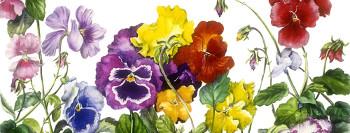Bio

Carolyn Cohen has been a professional artist for 30 years and turned to painting full time after many years in business. Part of her growing up experience was hiking with her family in the natural areas and parks in and around New York State, exploring undeveloped areas in New England, and, more recently, the native habitats in Florida. Carolyn is indebted to many botanical gardens for being able to paint on location. Her works include watercolors and hand painted etchings that combine the best of both media. For several years she has been creating an ongoing series of images depicting the structure and patterns of flowers.
In her studio, Carolyn works from live plant specimens, combining field sketches with the botanical subjects. Incorporating the traditions found in early botanical prints, paintings, calligraphy, Persian miniatures, and illuminated manuscripts, her work is an expressive interpretation of horticultural forms. Many of Carolyn’s paintings are in transparent watercolor as traditionally used on white paper. Other work is in opaque gouache and colored pencil on black paper. She uses watercolor in her etchings to create depth and shape, and to enhance the monochrome character of the print that is pulled from the etching plate.
Carolyn was born and grew up in Brooklyn, NY. She graduated from Hunter College High School and the City College of New York. For twenty years she worked at the Rockefeller Foundation and at New York University. From that time to the present, Carolyn has been an avid museum and gallery visitor in addition to attending many music and dance performances.
Her work has been in museum shows and touring exhibitions and is in a large number of public and private collections. She exhibits regularly in outdoor fine art shows and in galleries, and her work is included in numerous publications .
STATEMENT
My drawings are simply studies in linear shapes and textures. Each image is botanically accurate although not always scientifically precise. Many of the patterns I see are abstract even though the lines I draw appear representational. Plant anatomy and texture, movement and patterns are more important to my eye than the color and flowers.
My drawn lines are rarely straight; many are shaped by the “calligraphy” and rhythms I see in the plants. When I add color, the images seem to echo the artistry of early botanical scientist-artists, both Eastern and Western. Since I draw only from live subject matter, the drawings become portraits of the character of an individual plant at a given moment. As each plant responds to its environment, I include the element of time by depicting transitional views within the same drawing. Plants are the perfect studio models since they move very slowly in time.
Not all plants “speak” to me. I must find and choose a plant I want to draw. Perhaps it is hiding behind a wall or by the side of the road. Sometimes a wispy vine beckons as it waves in the wind, or a fraction of a larger landscape catches my eye. Isolating a plant from its context is necessary in order to focus on its unique form. Each subject becomes a memory trail that connects me to my own artistic context and world, creating a capsule of place and memory to revisit the joy of my childhood explorations.
I hope my artwork will encourage you to take time to look closely for beauty and strength in the natural world.

